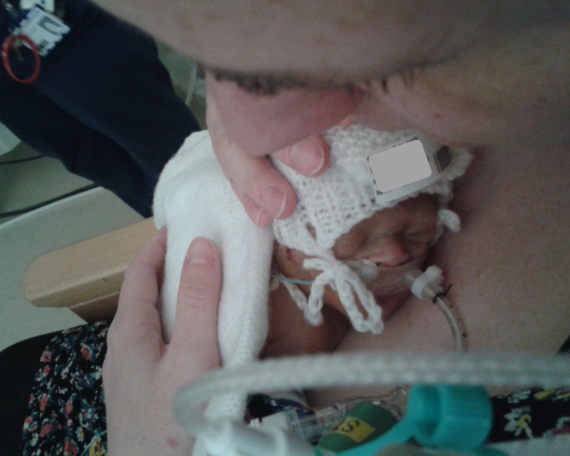Many proud new parents take for granted that they can take endless photographs of their new arrival. When a baby dies - before or soon after birth - there is only one chance to take photographs and create precious memories for the heartbroken parents.
My partner and I have hundreds of photos and videos of our son Hugo, who lived for 35 days. Hugo had been born when I was just 24 weeks' pregnant because I had the rare, life-threatening pregnancy illnesses preeclampsia and HELLP syndrome. He spent his life on a ventilator.
Our photos show Hugo's personality - lying back with his legs dangling over his nest, throwing his arms around, playing with the wires, or comfily lying in his favourite position on his tummy. Our videos show him boogying to my singing, and opening his eyes to peek out on the world.
Precious memories, every one.
My one regret of Hugo's life and death is not having a proper photo of the whole of his beautiful face.
Hugo was so tiny, weighing just 420 grams at birth. The tape securing the naso-gastric tube and the bows on his hat that kept the ventilator tube in place obscured his features.

These pieces of equipment helped keep Hugo alive, meaning the only opportunity we had to get a photo of Hugo's face without the paraphernalia was after he had died.
We didn't take a photo because it didn't feel right. Of course, we were not thinking straight - our baby had just died and we were utterly devastated. Hugo, our first and only child, was the first dead person we had ever seen. To take a photo of a dead baby seemed macabre - especially when he had been alive and literally kicking only a few hours before.
I think and know differently now. But it is too late.
I will be forever grateful to the neonatal unit where Hugo was looked after for everything they did to help save Hugo. We went in to a separate room to spend Hugo's last moments quietly together. The staff lent us the unit's camera, and we took a few photos of our final cuddles.
No one told us we couldn't take a photo, but no one told us we could, either.
I helped wash and dress Hugo, which I was very grateful to be able to do for my baby. Simple things that so many other mothers taken for granted - I knew it was the first and last time I would be able to do that for my son. We have hand and footprints, and a lock of his beautiful dark hair.
I spent a lot of time stroking Hugo's face and the little bit of hair sticking out of his hat - his hair was so soft.
We have some photos taken a couple of hours after Hugo's death - he was wrapped up in a blanket and you can't really see his face.
If you are a midwife or neonatal/paediatric nurse dealing with the death of a baby, please take a moment to gently mention to the parents the possibility of taking a photograph. Permission needs to be more than implied at such a distressing time - you might need to be more explicit.
Mention to the parents that they might think they don't want photos at that time, but they might change their minds in the future. You can explain that the hospital can look after the photos until the parents are ready to receive them. Of course, the hospital will need to comply with data protection laws - information about this and how the parents can get the photos whenever they are ready could be included in the bereavement literature.
Alternatively, if there is time the hospital could get in touch with a specialist bereavement photography charity such as Now I Lay Me Down to Sleep, (this US based charity is now operating in the UK, too) or UK charity Remember My Baby. As you'll see from the websites their photographers take beautiful black-and-white photos of babies and their families. Sadly, their services are required too often, and they always need more volunteer photographers. If you are a photographer who might be able to help, please do get in touch with them.
My story (the photography part at least) does have a happy ending of sorts. I am fortunate to have a wonderful photographer friend who offered to see if she was able to remove some of the medical equipment using Photoshop. I was delighted with the result, because they help me imagine what he would have looked like as a little boy.

Hugo lives on in our minds - and in our precious photographs. They are invaluable to me, just as baby photographs are to any parent. The fact that for bereaved parents these photographs are finite makes them even more precious.
Leigh Kendall also blogs at Headspace Perspective.